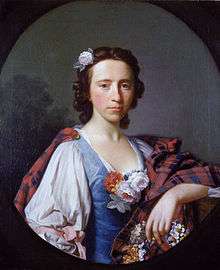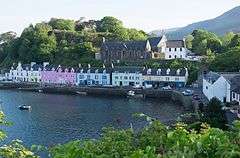Flora MacDonald
Flora MacDonald (Gaelic: Fionnghal nic Dhòmhnaill); (1722 – 5 March 1790) was a member of the Macdonalds of Sleat, who helped Charles Edward Stuart evade government troops after the Battle of Culloden in April 1746. Her family supported the government during the 1745 Rising and Flora later claimed to have assisted Charles out of sympathy for his situation.
Flora Macdonald | |
|---|---|
 Flora Macdonald by Allan Ramsay c. 1749–1750; the roses are a Jacobite symbol. Ashmolean Museum, Oxford. | |
| Born | 1722 Milton, South Uist, Scotland |
| Died | 5 March 1790 (aged 67–68) |
| Nationality | Scottish |
| Known for | assisting Charles Edward Stuart after his defeat at the Battle of Culloden |
| Signature | |
She was arrested and held in the Tower of London but released under a general amnesty in June 1747. She later married Allan MacDonald and the couple emigrated to North Carolina in 1773. Their support for the British government during the American War of Independence meant the loss of their American estates and they returned to Scotland, where Flora died in 1790.
Early life

Flora was born in 1722 at Milton on the island of South Uist in the Outer Hebrides, third and last child of Ranald MacDonald (d. 1723) and his second wife Marion. Her father was a member of the minor gentry, being tacksman and leaseholder of Milton and Balivanich; she had two brothers, Angus, who later inherited the Milton tack and Ronald, who died young.[1]
Her father died soon after her birth and in 1728, her mother remarried Hugh MacDonald of Armadale, Skye. Flora was brought up by her father's cousin, Sir Alexander MacDonald of Sleat and suggestions she was educated in Edinburgh have not been confirmed. While some MacDonalds remained Catholic, particularly in the Islands, her family was part of the Presbyterian majority.[1]
The escape of Prince Charles Edward Stuart
Flora was visiting Benbecula in the Outer Hebrides when Prince Charles and a small group of aides took refuge there after the Battle of Culloden in June 1746. One of his companions, Captain Conn O'Neill from County Antrim, was distantly related to Flora and asked for her help.
MacDonald of Sleat had not joined the Rebellion and Benbecula was controlled by a pro-government militia commanded by Flora's step-father, Hugh MacDonald. This connection allowed her to obtain the necessary permits but she apparently hesitated, fearing the consequences for her family if they were caught. She may have been taking less of a risk than it appears; witnesses later claimed Hugh advised the Prince where to hide from his search parties.[2]
Passes were issued allowing passage to the mainland for Flora, a boat's crew of six men and two personal servants, including Charles disguised as an Irish maid called Betty Burke. On 27 June, they landed near Sir Alexander's house at Monkstadt, near Kilbride, Skye. In his absence, his wife Lady Margaret arranged lodging with her steward, MacDonald of Kingsburgh, who told Charles to remove his disguise, as it simply made him more conspicuous. The next day, Charles was taken from Portree to the island of Raasay; Flora remained on Skye and they never met again.[3]

Two weeks later, the boatmen were detained and confessed; Flora and Kingsburgh were arrested and taken to the Tower of London. After Lady Margaret interceded on her behalf with the chief Scottish legal officer, Duncan Forbes of Culloden, she was allowed to live outside the Tower under the supervision of a "King's Messenger" and released after the June 1747 Act of Indemnity.[4] Aristocratic sympathisers collected over £1,500 for her, one of the contributors being Frederick, Prince of Wales, heir to the throne; Flora allegedly told him she helped Charles out of charity and would have done the same for him.[5]
On 6 November 1750, at the age of 28, she married Allan MacDonald, a captain in the British army and Kingsburgh's eldest son.[6] The couple first lived at Flodigarry, Skye and inherited the family estate after Kingsburgh died in 1772. The writer Samuel Johnson, who met her in 1773 during his visit to the island, described her as "a woman of soft features, gentle manners, kind soul and elegant presence". He was also author of the inscription on her memorial at Kilmuir: "a name that will be mentioned in history, and if courage and fidelity be virtues, mentioned with honour".[7]
Emigration to North Carolina
Allan MacDonald served in the 114th and 62nd Regiments of Foot during the 1756–1763 Seven Years' War but was a poor businessman. After quarrelling with his clan chief over rent, he and Flora emigrated to Anson County, North Carolina in 1774 where they settled on an estate near Mountain Creek, named 'Killegray'.[8] When the American War of Independence began in 1775, Allan raised the Anson Battalion of the Loyalist North Carolina Militia, a total of around 1,000 men, including his sons Alexander and James. En route to the coast for collection by British transports, they were attacked by an American force at the Battle of Moore's Creek Bridge on 28 February 1776 and Allan was taken prisoner.[9]
In April 1777, the North Carolina Provincial Congress confiscated Loyalist-owned property and Flora was evicted from Killegray, with the loss of all her possessions.[10] After 18 months in captivity, Allan was released in September 1777; he was posted to Fort Edward, Nova Scotia as commander of the 84th Regiment of Foot where Flora joined him in August 1778.[11]
Return to Skye

After a harsh winter in Halifax, Nova Scotia, in September 1779 Flora took passage for London in the Dunmore, a British privateer; during the voyage, she broke her arm and ill-health delayed her return to Scotland until spring 1780.[12]
She spent the next few years living with various family members, including Dunvegan, home of her son-in-law Major General Alexander Macleod, the largest landowner in Skye after the MacDonalds.[13] The compensation received for the loss of their North Carolina estates was insufficient to allow them to settle in Nova Scotia and Allan returned to Scotland in 1784. Since Kingsburgh was now occupied by Flora's half-sister and her husband, Flora and Allan settled on the nearby tack of Penduin.[14]
She died in 1790 at the age of 68 and was buried in Kilmuir Cemetery, her husband following in September 1792. They had seven surviving children, two daughters and five sons, two of whom were lost at sea in 1781 and 1782; a third son John made his fortune in India, enabling his parents to spend their last years in some comfort.[1]
Legacy

Traditional portrayals of the escape focus on Charles, Flora being relegated to a secondary role and receiving less credit than is her due. She rarely spoke of the episode and her last contact with Charles was when they parted ways at Portree; it appears at least one motive was that his presence endangered her family.[15]
The Victorians created a Scottish cultural identity expressed through tartans, the late 19th-century inventions of Burns Suppers and Highland Games, and the co-option of romantic icons like Mary, Queen of Scots and Bonnie Prince Charlie.[16] In 1878, Flora took her place in this pantheon with the publication of an alleged 'Autobiography'; ghost-written by her granddaughter Flora Frances Wylde, this contains so many errors it could not have been written by her.[1] Repeated by Charles Ewald in his 1886 book The Life and Times of Prince Charles Edward, it remains the basis for many popular perspectives on her life and motivations.[1]
In 1884, Sir Harold Boulton wrote an adaptation of an existing melody which he named 'The Skye Boat Song'. This was soon followed by the first performance of the Scottish highland dance "Flora MacDonald's Fancy", while a bronze statue was erected at Inverness Castle in 1896.[17] The Flora MacDonald Academy, formerly Flora Macdonald College, in Red Springs, North Carolina is named after her and two of her children are interred on the campus; until 2009, it was also the site of the Flora Macdonald Highland Games.
Flora was painted several times by Scottish portrait artist Allan Ramsay (1713–1784), the majority of which were destroyed. The one used in this article was done after her release from the Tower in 1749–1750; in 2015, a previously unrecorded painting, allegedly also by Ramsay, was discovered in Florida.[18]
Fictional portrayals include;
- Inglis Fletcher, The Scotswoman (1954); a novel based on Flora MacDonald's life in North Carolina during the American War of Independence;
- Highlander: The Series; in the 3rd-season episode, "Take Back the Night", Ceirdwyn, an Immortal, is living under the name "Flora MacDonald" when Charles and his party stop on their way to the coast, seeking a boat to France;
- A Breath of Snow and Ashes; the 6th book of Diana Gabaldon's The Outlander series, the episode features an account of Flora MacDonald's arrival in the American colonies.
In the 1948 film Bonnie Prince Charlie, Flora is portrayed by Margaret Leighton, with David Niven as Charles. He later recalled it as "...one of those huge, florid extravaganzas that reek of disaster from the start."
References
- Douglas & Oxford DNB Online.
- Riding 2016, pp. 465-467.
- Riding 2016, pp. 467-468.
- Riding 2016, pp. 468-469.
- MacLoed 1985, p. 90.
- MacInnes 2009, pp. 15-24.
- Bate 1955, p. 463.
- Quyn 1963, p. 74.
- McConnell, Brian. "A Highlander & Loyalist – Alan MacDonald" (PDF). UE.org. Mr McConnell's article provides third party references for the points included here. Retrieved 2 August 2018.
- Meyer, p.75.
- Quyn 1963, pp. 249-250.
- Quyn 1963, p. 251.
- MacGregor 2009, p. 134.
- Quyn 1963, p. 256.
- Riding 2016, p. 465.
- Morris 1992, pp. 37-39.
- Historic Environment Scotland. "Inverness, Castle Wynd, Statue Of Flora Macdonald (13434)". Canmore. Retrieved 26 January 2015.
- "'Flora MacDonald portrait' found in Florida". BBC News. 31 March 2015. Retrieved 22 July 2018.
Sources
- Bate, W Jackson (1955). The Achievement of Samuel Johnson. OUP. ISBN 978-0195004762.CS1 maint: ref=harv (link)
- Douglas, Hugh; Flora MacDonald: The Most Loyal Rebel; (Sutton Publishing, 1999);
- Douglas, Hugh. Flora MacDonald. Oxford DNB Online.CS1 maint: ref=harv (link)
- McConnell, Brian. "A Highlander & Loyalist – Alan MacDonald" (PDF). UE.org.
- MacInnes, John (December 2009). The Brave Sons of Skye; Containing the Military Records (compiled From Authentic Sources) of the Leading Officers, Non-Commissioned Officers, and private soldiers whom "Eilean a' Cheo" has produced.CS1 maint: ref=harv (link)
- MacLeod, Ruairidh (1985). Flora MacDonald: The Jacobite Heroine in Scotland and North America. Shepheard-Walwyn. ISBN 978-0856831478.CS1 maint: ref=harv (link)
- MacGregor, Alexander (December 2009). The life of Flora Macdonald, and her adventures with Prince Charles (Print On Demand ed.). Nabu Press.CS1 maint: ref=harv (link)
- Meyer, Duane (1963). The Highland Scots of North Carolina. Raleigh, N.C.: Carolina Charter Tercentenary Commission.CS1 maint: ref=harv (link)
- Morris, RJ (1992). "Victorian Values in Scotland & England". Proceedings of the British Academy (78).CS1 maint: ref=harv (link)
- Quyn, Dorothy Mackay (July 1941). "Flora MacDonald in History". The North Carolina Historical Review. 18 (3).CS1 maint: ref=harv (link)
- Riding, Jacqueline (2016). Jacobites; A New History of the 45 Rebellion. Bloomsbury. ISBN 978-1408819128.CS1 maint: ref=harv (link)
External links
- McConnell, Brian. "A Highlander & Loyalist – Alan MacDonald" (PDF). UE.org. Mr McConnell's article provides third party references for the points included here. Retrieved 2 August 2018.
- "'Flora MacDonald portrait' found in Florida". BBC News. 31 March 2015. Retrieved 22 July 2018.
- Historic Environment Scotland. "Inverness, Castle Wynd, Statue Of Flora Macdonald (13434)". Canmore. Retrieved 26 January 2015.
- "'Flora MacDonald portrait' found in Florida". BBC News. 31 March 2015. Retrieved 22 July 2018.
